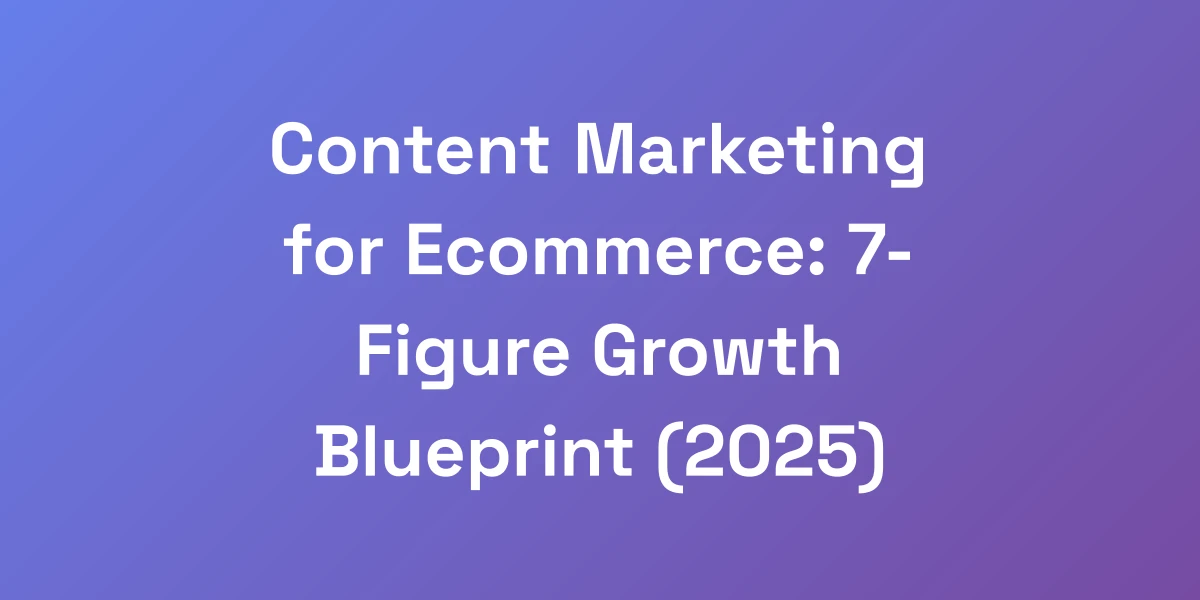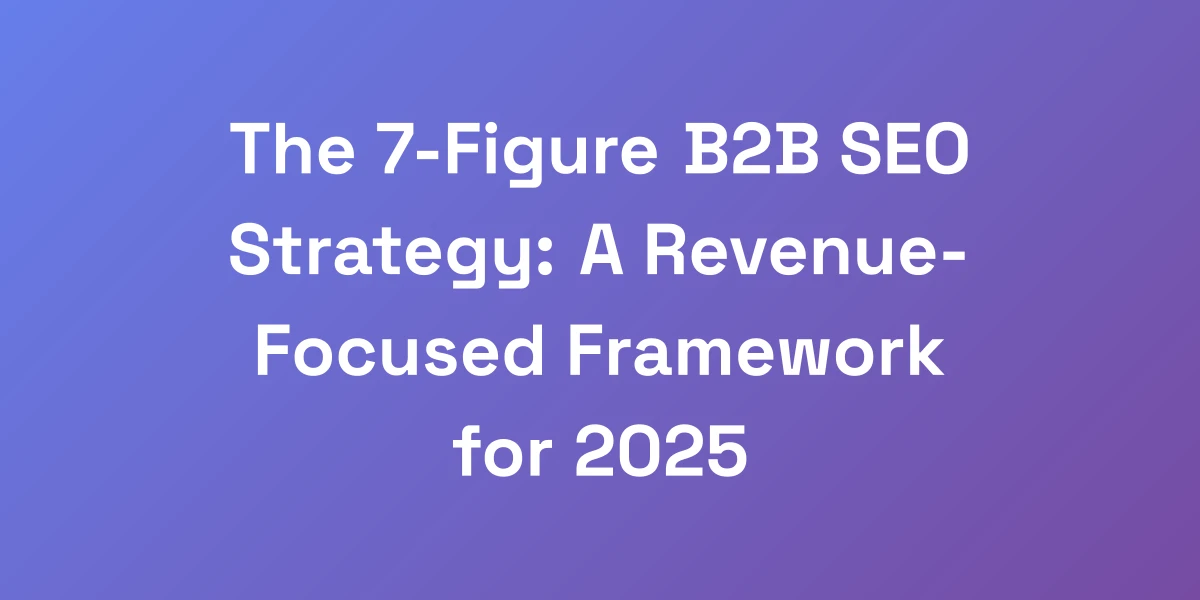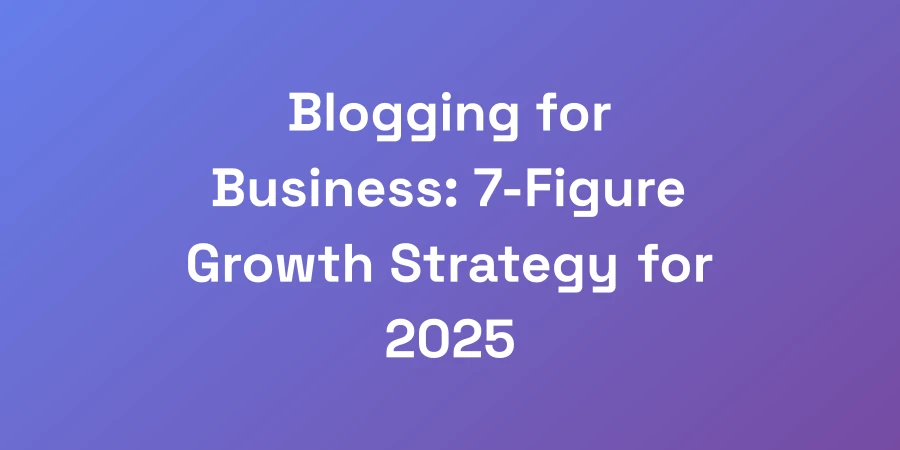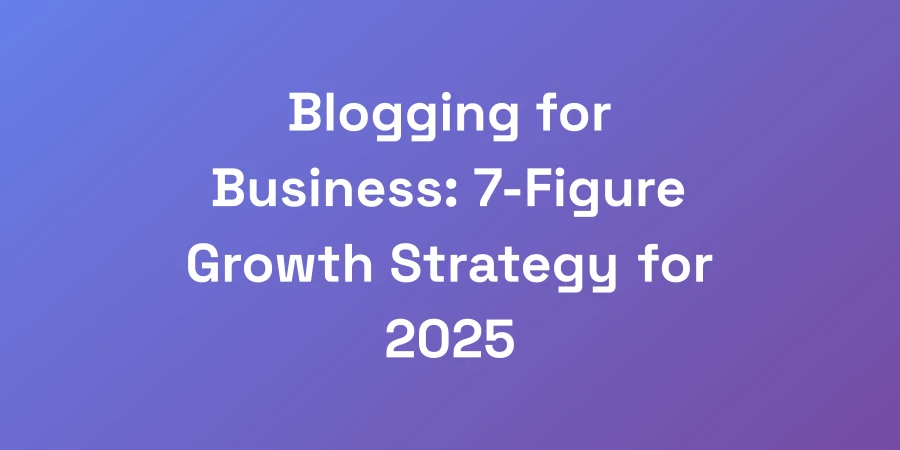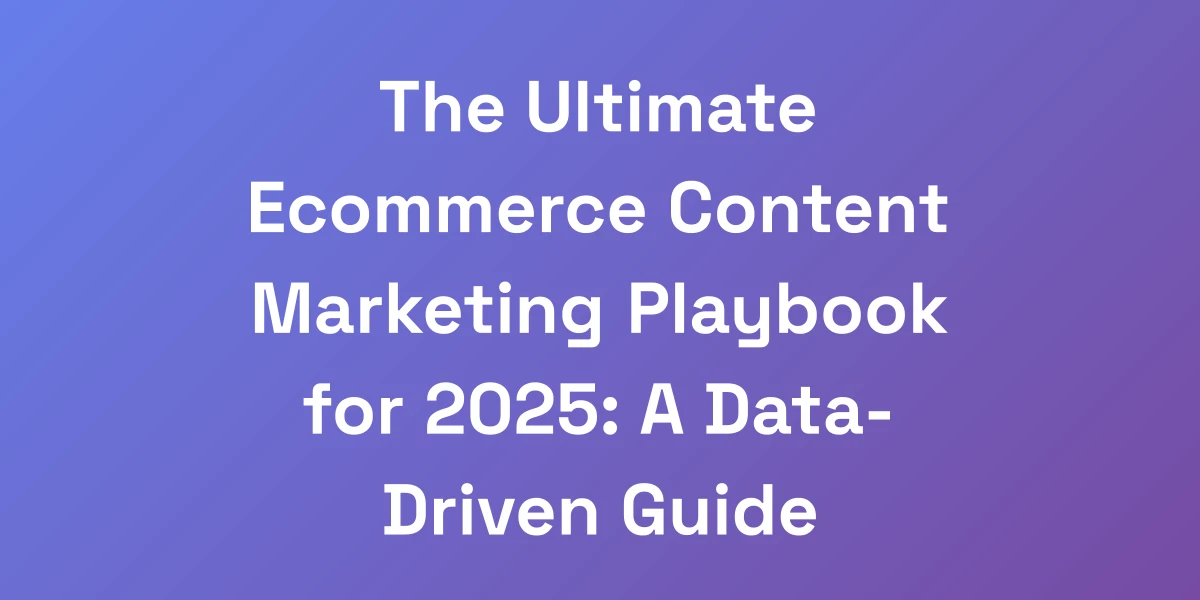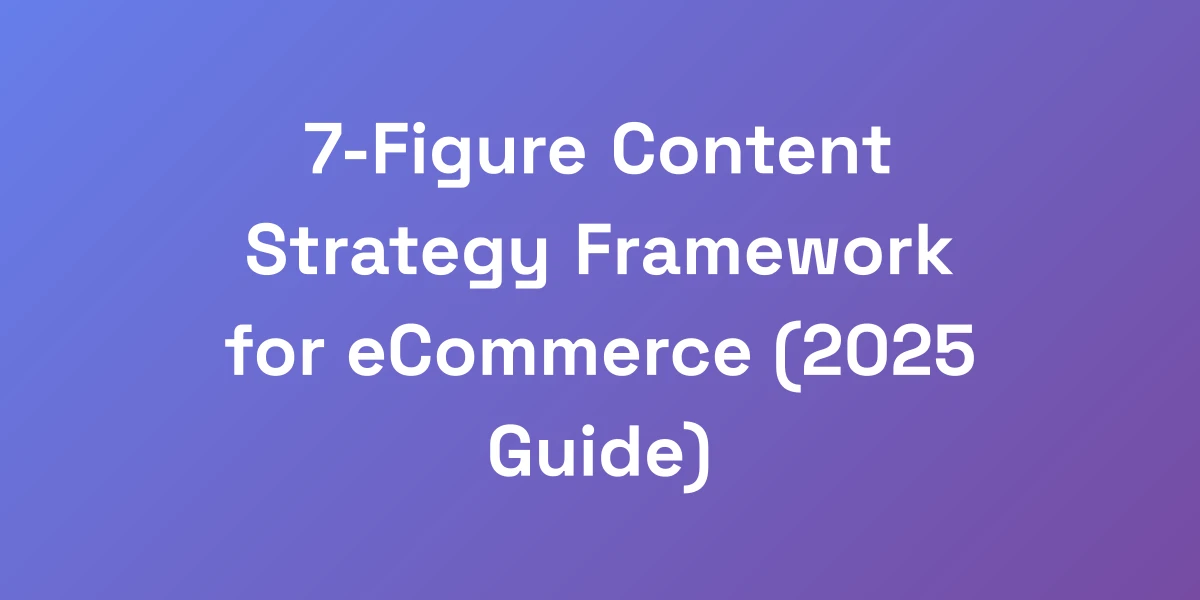
7-Figure Content Strategy Framework for eCommerce (2025 Guide)
Mar 18, 2025 | By [email protected]
7-Figure Content Strategy Framework for eCommerce (2025 Guide)
Let’s cut to the chase—your eCommerce content strategy is either scaling you to seven figures or burning through your budget with no returns. We’ve seen it all: countless stores pouring money into content that falls flat, failing to turn casual browsers into loyal buyers. It’s frustrating, right?
The problem isn’t your products or your website—it’s your content strategy. Most eCommerce businesses create content for the sake of it, chasing vanity metrics like likes and shares without tying their efforts to concrete sales goals. Imagine investing time and resources into blog posts and social media updates that don’t contribute to your bottom line. It’s a recipe for stagnation.
But there’s a better way. In this guide, we’ll reveal a 7-figure content strategy framework tailored for eCommerce, crafted from our experience working with top-tier stores. We’re not here to offer fluff or theories—we’re here to deliver battle-tested strategies that drive consistent revenue. Ready to transform your content into a powerhouse for sales? Let’s get into it.
Why Most eCommerce Content Strategies Fail (And How to Win)
Let me be brutally honest—in eCommerce, 95% of content strategies are just burning money. We’ve consulted for hundreds of 7-8 figure stores, and they all make the same deadly mistake: creating content that doesn’t convert browsers into buyers. Your blog posts and social media content mean nothing if they don’t drive sales.
The Fatal Flaws in Traditional eCommerce Content
Traditional content strategies focus on creating as much content as possible, hoping something will stick. But what’s the point of a massive content library if it’s not converting?
- Lack of Focus on Revenue: Content isn’t aligned with sales goals.
- Ignoring Buyer Psychology: Not matching content to the buyer’s journey.
- Inadequate Metrics: Tracking vanity metrics instead of actionable ones.
These missteps lead to wasted resources and minimal returns. It’s time to shift the focus from quantity to quality and strategic alignment with revenue goals.
The Revenue-First Content Approach
We prioritize content that directly impacts your revenue streams. It’s about creating strategically crafted content that guides potential customers through the sales funnel. From attracting the right audience to building trust and closing sales, every piece of content serves a specific purpose.
Actionable tips:
- Identify key revenue drivers and align your content to support them.
- Create content that addresses specific pain points and solutions for your audience.
- Integrate clear calls-to-action (CTAs) that guide users towards a purchase.
Key Metrics That Actually Matter
Forget likes and shares—focus on metrics that drive business growth:
- Conversion Rates: The percentage of visitors who make a purchase.
- Customer Lifetime Value (CLV): The total revenue a customer generates over their lifespan.
- Return on Investment (ROI): The profitability of your content efforts.
By tracking these metrics, you can measure the true impact of your content strategy and make data-driven decisions to optimize performance.
Setting Up Your Content for Conversion
Creating content is easy; creating content that converts is an art. Here’s how to set up your content for maximum conversion:
- Understand Your Audience: Know their needs, preferences, and pain points.
- Use Persuasive Copywriting: Craft compelling headlines, clear benefits, and strong CTAs.
- Optimize for SEO: Ensure your content ranks well by using the best SEO tools for agencies.
Each element plays a crucial role in guiding the customer journey from awareness to decision.
Quick Wins vs. Long-Term Strategy
Balancing quick wins with a long-term strategy is essential for sustained growth. Quick wins are your fast-acting content pieces that generate immediate sales, while long-term strategies build brand authority and steady revenue streams.
Actionable tips:
- Quick Wins: Promotional emails, limited-time offers, and high-conversion landing pages.
- Long-Term Strategy: Comprehensive blog content, evergreen resources, and robust SEO.
By integrating both approaches, you ensure continuous revenue generation while building a strong foundation for future growth.
The 3-Phase Content Conversion Framework
After testing countless approaches across different niches, we’ve distilled content strategy down to three critical phases that maximize ROI. This isn’t about creating more content—it’s about creating the right content at the right time. Our framework focuses on matching buyer psychology with content type, ensuring every piece serves a specific purpose in the sales process.
Phase 1: Attraction Content That Pre-Qualifies
At this stage, the goal is to attract potential customers and pre-qualify them. This content should be engaging and informative, capturing the interest of those who are just beginning their buyer journey.
- Blog Posts: Address common problems and provide valuable insights.
- Social Media Content: Shareable content that raises brand awareness.
- SEO Optimized Content: Ensure your content ranks for relevant keywords to drive organic traffic.
Example: A blog post addressing “10 Ways to Improve Your Home Office Setup” attracts a broad audience interested in home office solutions, pre-qualifying them for related products.
Phase 2: Consideration Content That Builds Trust
Once you have their attention, it’s time to build trust and nurture leads. This phase involves deeper engagement with content that demonstrates your expertise and reliability.
- Case Studies: Showcase real-life examples of your product in action.
- How-To Guides: Provide comprehensive information that helps solve specific problems.
- Webinars and Live Q&A: Interactive content that engages and educates your audience.
Example: A case study detailing how a customer increased their productivity using your ergonomic chair builds trust and showcases the product’s value.
Phase 3: Decision Content That Closes Sales
This is where you seal the deal. Decision-content is designed to remove any final barriers to purchase and encourage conversion.
- Product Demos: Show how your product works in real-time.
- Customer Testimonials: Genuine reviews and success stories that add credibility.
- Exclusive Offers: Limited-time discounts or bonuses to incentivize immediate action.
Example: A video demonstrating the features of your smartwatch, combined with customer testimonials and a limited-time discount, can push hesitant buyers to make a purchase.
Content Mapping for Maximum Impact
Content mapping ensures every piece of content is strategically placed to guide the customer through their journey. It’s about delivering the right content at each phase to facilitate smooth transitions and maximize conversions.
- Awareness Stage: Broad, informative content like blogs and social media posts.
- Consideration Stage: In-depth content such as guides, webinars, and case studies.
- Decision Stage: Conversion-focused content including demos, testimonials, and special offers.
This strategic alignment ensures that your content ecosystem works cohesively to drive sales.
Measuring Success at Each Phase
To ensure your content strategy is effective, you need to measure success at each phase. This involves tracking specific metrics that align with your goals.
- Attraction Phase: Website traffic, social shares, and keyword rankings.
- Consideration Phase: Engagement metrics, time on page, and lead generation.
- Decision Phase: Conversion rates, sales numbers, and ROI.
Regularly evaluating these metrics allows you to refine your strategy and ensure each phase is contributing to your overall revenue goals.
High-Converting Content Types for Each Stage
Here’s what nobody tells you about eCommerce content—different formats have different conversion rates at each stage of the buyer’s journey. We’ve tracked millions in sales back to specific content types, and the data is clear: some best types of content consistently outperform others by 300-400%.
Top-Performing Attraction Content Formats
Attraction content is all about drawing in potential customers. The key formats here are those that are easily discoverable and shareable.
- SEO-Optimized Blog Posts: Capture organic traffic by targeting relevant keywords.
- Social Media Posts: Engage audiences on platforms where they spend their time.
- Infographics: Visual content that simplifies complex information and is highly shareable.
Example: A blog post titled “Top 10 Trends in Sustainable Fashion for 2025” leverages SEO to attract users interested in eco-friendly fashion, setting the stage for further engagement.
Trust-Building Content That Converts
Once you’ve attracted your audience, the next step is to build trust. Content that demonstrates your expertise and reliability is crucial in this phase.
- Case Studies: Highlight successful implementations of your product.
- How-To Guides: Provide detailed instructions that solve specific problems.
- Webinars and Live Sessions: Interactive content that allows direct engagement and education.
Example: A detailed guide on “How to Choose the Right Running Shoes” not only educates the reader but also subtly highlights your product’s unique features.
Sales-Closing Content Examples
This is the moment to convert. Sales-closing content must be persuasive and action-oriented.
- Product Demos: Show how your product works in real-time.
- Customer Testimonials: Genuine reviews and success stories that add credibility.
- Exclusive Offers: Limited-time discounts or bonuses to incentivize immediate action.
Example: A video showcasing a product’s features, combined with a special discount code, can significantly increase conversion rates by addressing final purchase hesitations.
Content Distribution Strategy That Drives Sales
Creating great content is only 20% of the battle. The real money is in the distribution strategy. Most eCommerce brands waste thousands on random promotion tactics that don’t work. Instead, we use a systematic approach to get content in front of buyers who are ready to purchase through effective digital marketing for small businesses.
Platform Selection Based on Buyer Behavior
Not all platforms are created equal. Choose where to distribute your content based on where your buyers spend their time.
- Instagram and TikTok: Ideal for younger demographics and visual content.
- Facebook: Great for broader audiences and targeted advertising.
- LinkedIn: Perfect for B2B content and professional engagement.
Understanding your audience’s preferred platforms ensures your content reaches the right people at the right time.
Timing and Frequency Optimization
When and how often you post can significantly impact your content’s effectiveness.
- Analyze Peak Times: Use analytics to determine when your audience is most active.
- Consistent Posting Schedule: Maintain regular posting to keep your audience engaged.
- Content Calendar: Plan your content distribution to maximize reach and engagement.
Investing time in timing and frequency optimizes your content’s visibility and engagement.
Cross-Platform Content Synergy
Don’t let your content exist in silos. Create synergy across platforms to amplify your message.
- Repurpose Content: Adapt blog posts into social media snippets or videos.
- Consistent Branding: Ensure your brand voice and messaging remain consistent across all platforms.
- Integrated Campaigns: Coordinate campaigns across different channels for a unified approach.
This unified strategy enhances your brand’s presence and reinforces your message across multiple touchpoints.
Paid vs. Organic Distribution
Balancing paid and organic distribution is key to maximizing reach and ROI.
- Organic Efforts: Focus on SEO, social media engagement, and content marketing to build a sustainable presence.
- Paid Advertising: Use targeted ads to amplify your content’s reach and drive immediate traffic.
- Retargeting Campaigns: Capture potential customers who’ve interacted with your content but haven’t converted yet.
Strategically using both paid and organic methods ensures comprehensive coverage and sustained traffic.
Analytics and Optimization Process
Data is your best friend. Regularly analyze your distribution efforts to identify what’s working and what’s not.
- Performance Metrics: Track engagement rates, click-through rates, and conversion rates.
- Adjust Strategies: Use data insights to tweak your distribution tactics for better results.
- Continuous Improvement: Always look for ways to optimize and refine your distribution approach.
This ongoing process ensures your content distribution remains effective and aligned with your sales goals.
Scaling Your Content Operation
Turning your content strategy into a systematic revenue generator requires scalability. Most eCommerce brands hit a wall because they can’t scale their content operations efficiently. We’ve built a repeatable system that scales content production without sacrificing quality or ROI.
Building Your Content Team
A strong team is the backbone of any scalable content operation. Here’s how to build yours:
- Define Roles Clearly: From content creators to strategists, ensure everyone knows their responsibilities.
- Hire Specialized Talent: Bring in experts for different content formats and stages of the buyer journey, including SEO freelancers.
- Foster Collaboration: Encourage teamwork and communication to maximize efficiency and creativity.
A well-structured team ensures consistency and quality as you scale your content efforts.
Content Production Systems
Efficiency is key when scaling. Implement systems that streamline your content production process.
- Content Management Tools: Use platforms like StoryChief to organize and manage your content.
- Standardized Workflows: Develop processes for content creation, editing, and publishing to ensure consistency.
- Automation: Leverage tools like ContentBot.ai and digital marketing for agencies to automate repetitive tasks and enhance productivity.
These systems help maintain high standards while increasing output.
Quality Control Processes
Scaling shouldn’t mean compromising on quality. Implement rigorous quality control measures:
- Editorial Guidelines: Establish clear guidelines to maintain a consistent tone and style.
- Regular Audits: Periodically review content to ensure it meets your standards.
- Feedback Loops: Encourage team members to provide and receive feedback to continually improve.
Maintaining quality ensures your content remains effective and trustworthy as you grow.
ROI Tracking and Optimization
As you scale, it’s crucial to keep track of your ROI and optimize accordingly.
- Comprehensive Analytics: Use tools like HubSpot to track performance across all content channels.
- Identify High Performers: Focus on content types and strategies that yield the highest returns.
- Continuous Testing: Experiment with different approaches to find the most effective tactics.
Regularly assessing ROI allows you to allocate resources effectively and maximize profitability.
Automation and Tools
Leverage automation tools to scale efficiently without increasing workload:
- Content Automation Tools: Platforms like autoblogging and ContentBot.ai streamline content creation and management.
- Marketing Automation: Tools like HubSpot automate marketing tasks, freeing up time for strategic work.
- Analytics Tools: Use advanced analytics to monitor and optimize content performance in real-time.
Automation not only increases efficiency but also ensures consistency and precision in your content operations.
Conclusion
We’ve walked through a comprehensive framework for building a 7-figure content strategy tailored for eCommerce. By addressing the common pitfalls, adopting a revenue-first approach, and leveraging the 3-phase content conversion framework, you can transform your content from mere noise to a powerful sales engine.
Remember, it’s not about creating more content—it’s about creating the right content at the right time.
Are you ready to implement these strategies and take your eCommerce business to the next level? Start by evaluating your current content strategy against our framework and identify areas for improvement. Need help getting started? Reach out to us, and we’ll guide you through the process.
What’s your biggest content challenge right now? Drop a comment below or share your thoughts on social media using #7FigureContentStrategy. Let’s build a community of eCommerce success together.



